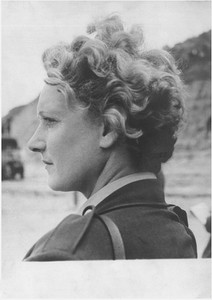Germaine Kanova, born Germaine Osstyn on 31 August 1902 in Boulogne-sur-Mer, France, was a pioneering war photographer who captured striking images during and after the Second World War. Raised near the front lines of the First World War, she spent part of her youth in cellars to escape bombardments. Originally drawn to music, she turned to photography in the 1930s after a period of personal turmoil, including two failed marriages. She trained in Vienna and opened her own portrait studio in London by the late 1930s.
In London, Kanova gained recognition for her dramatic use of lighting and composed portraits of figures such as George Bernard Shaw and Irene Vanbrugh. She became involved with the Free French circles, photographing General de Gaulle in 1942 and producing visual propaganda. Her wartime studio also became a training ground for young women photographers, including future artists and Resistance members.
Following the Allied landings in Normandy, Kanova returned to France in August 1944. Embedded with French units, she photographed the Liberation of Paris and joined the maquis in southwest France, where she earned the nickname “Miss Caméra.” She documented operations in areas still held by German troops, including the pockets of Royan and Lorient. In April 1945, she photographed the survivors and dead at the Vaihingen concentration camp, producing images that remain powerful records of Nazi atrocities.
After the war, she joined the French Army’s photographic service (SCA) and covered the campaigns in Alsace and Germany, often placing herself in combat zones. She was awarded the Croix de Guerre for her actions. In 1946, she travelled with the United Nations Relief and Rehabilitation Administration (UNRRA) to Poland, documenting postwar conditions.
Kanova continued working as a photographer into the 1950s, capturing portraits of artists, writers, and actors. She later left the profession without explanation, ran a café-cinema in rural France, and spent her final years in Antibes. She died on 27 January 1975 at the age of 72. Her legacy, long overlooked, has recently been rediscovered through exhibitions and archives, revealing her unique role as a woman behind the lens during a critical period in European history.
